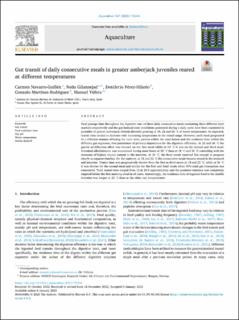| dc.contributor.author | Navarro-Guillén, Carmen | |
| dc.contributor.author | Gilannejad, Neda | |
| dc.contributor.author | Pérez-Hilario, Desiderio | |
| dc.contributor.author | Martínez-Rodríguez, Gonzalo | |
| dc.contributor.author | Yúfera, Manuel | |
| dc.date.accessioned | 2023-08-17T10:33:39Z | |
| dc.date.available | 2023-08-17T10:33:39Z | |
| dc.date.created | 2023-02-13T14:02:36Z | |
| dc.date.issued | 2023 | |
| dc.identifier.citation | Aquaculture. 2023, 567 . | en_US |
| dc.identifier.issn | 0044-8486 | |
| dc.identifier.uri | https://hdl.handle.net/11250/3084550 | |
| dc.description.abstract | Feed passage time throughout the digestive tract of three daily consecutive meals containing three different inert markers respectively and the gut luminal ionic conditions generated during a daily cycle have been examined in juveniles of greater amberjack (Seriola dumerili) growing at 18, 22 and 26 °C of water temperature. As expected, transit time tended to decrease with increasing temperature in the tested range. However, each meal progressed in a different manner affecting the ionic daily pattern within the tract lumen and the residence time within the different gut segments, two parameters of primary importance for the digestion efficiency. At 22 and 26 °C the gastric acidification effort was focused on the first meal whilst at 18 °C it was on the second and third meal. Intestinal alkalinisation was maintained during more hours at 22 °C than at 18 °C and 26 °C coinciding with the moments of highest chyme content in the intestine. At 26 °C, the three meals transited fast enough to progress clearly as separate batches. On the contrary, at 18 and 22 °C the consecutive meals became mixed in the stomach and intestine. Transit time was progressively shorter from the first to third meals at 18 and 22 °C, while at 26 °C it was shorter for the second meal and similar for the first and third meals when 95% total gut evacuation was considered. Total transit time ranged from 12 to 24 h approximately and the posterior intestine was completely emptied before the first morning meal in all cases. Interestingly, the residence time of ingested food in the middle intestine was longer at 22 °C than at the other two temperatures. | en_US |
| dc.language.iso | eng | en_US |
| dc.rights | Attribution-NonCommercial-NoDerivatives 4.0 Internasjonal | * |
| dc.rights.uri | http://creativecommons.org/licenses/by-nc-nd/4.0/deed.no | * |
| dc.title | Gut transit of daily consecutive meals in greater amberjack juveniles reared at different temperatures | en_US |
| dc.title.alternative | Gut transit of daily consecutive meals in greater amberjack juveniles reared at different temperatures | en_US |
| dc.type | Peer reviewed | en_US |
| dc.type | Journal article | en_US |
| dc.rights.holder | © 2023 The Authors | en_US |
| dc.description.version | publishedVersion | en_US |
| cristin.ispublished | true | |
| cristin.fulltext | original | |
| cristin.qualitycode | 2 | |
| dc.identifier.doi | 10.1016/j.aquaculture.2023.739244 | |
| dc.identifier.cristin | 2125651 | |
| dc.source.journal | Aquaculture | en_US |
| dc.source.volume | 567 | en_US |
| dc.source.pagenumber | 10 | en_US |

